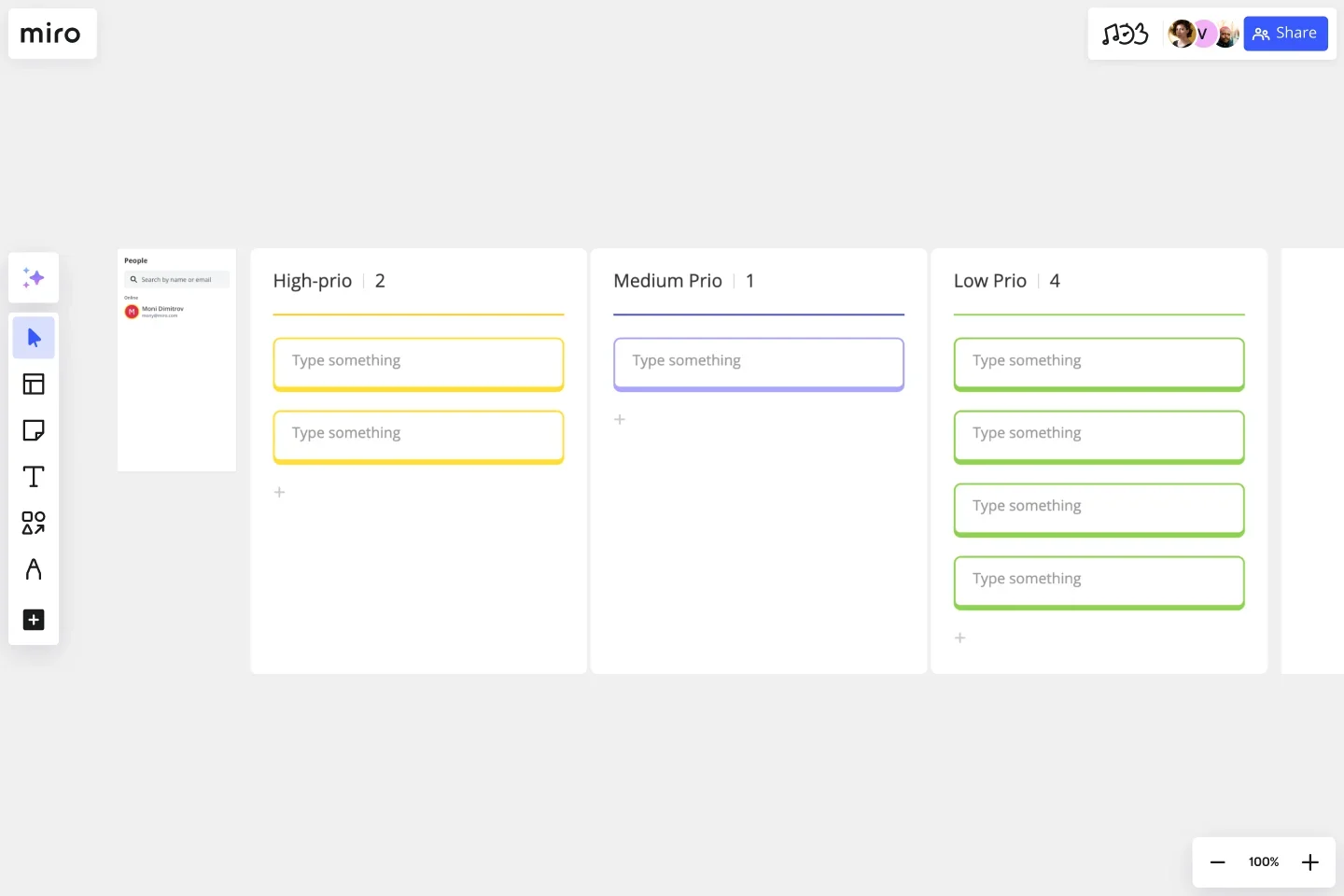
Daily stand-up questions for engaging meetings

Summary
In this guide, you will learn:
Purpose and structure of daily stand-up meetings.
The three core daily stand-up questions.
How to run effective daily stand-ups.
Ways to enhance remote team stand-ups.
How Miro's daily stand-up templates streamline meetings.
Best practices for customizing daily stand-up formats.
Daily stand-ups are the heartbeat of agile teams, keeping everyone in sync and on track. But what makes these quick meetings so effective? It’s all about asking the right questions. Let’s dive into the world of daily stand-up questions and discover how they can transform your team’s workflow.
How daily stand-ups work
Daily stand-ups, also known as daily scrums, are short, focused meetings held every day by agile teams. Typically lasting 15 minutes, these meetings are designed to keep everyone aligned, identify obstacles, and plan the day’s work. They’re a cornerstone of agile methodologies, fostering transparency and collaboration.
In a daily stand-up, each team member answers a set of predefined questions, usually while standing to keep the meeting brief and energetic. The goal is to provide quick updates, not to dive into detailed discussions. This format helps teams stay agile and responsive to changes.
Common daily stand-up questions
Certain questions are staples in daily stand-ups because they cover the essentials. Here are the most common daily stand-up questions:
What did you accomplish yesterday? This question helps the team understand progress and celebrate small wins. For instance, a developer might say, “I completed the user authentication module.”
What are you working on today? It sets the focus for the day and aligns everyone’s efforts. A team member might respond, “I’m starting on the payment gateway integration.”
Are there any blockers? Identifying obstacles early allows the team to address them promptly, preventing delays. Someone might mention, “I’m waiting for the API documentation from the client.”
These questions create a rhythm and ensure that everyone is on the same page.
Tailoring questions to your team’s needs
Every team is unique, and so are their needs. Tailoring your daily stand-up questions can make these meetings even more effective. Consider the following tips:
Project phase: During the planning phase, you might ask, “What are our priorities for this sprint?” In the testing phase, “What bugs need immediate attention?” could be more relevant.
Team dynamics: If your team is remote, include questions like, “Do you need any support with remote tools?” For new teams, “What did you learn yesterday?” can foster a learning culture.
Customizing questions ensures they resonate with your team’s current context and challenges. For example, a team working on a tight deadline might benefit from the question, “What can we do to speed up our progress?”
Creative and engaging stand-up questions
Spice up your stand-ups with creative questions that keep the team engaged. Here are some ideas:
What’s one thing you’re excited about today? This adds a positive note to the meeting and can boost morale. For example, a designer might say, “I’m excited to start working on the new UI design.”
What’s a recent success you’re proud of? Celebrating achievements boosts morale. A team member might share, “I’m proud that we successfully deployed the new feature without any issues.”
If you could change one thing about our process, what would it be? This encourages continuous improvement. Someone might suggest, “I think we could improve our code review process to catch bugs earlier.”
These questions not only make stand-ups more enjoyable but also promote a culture of openness and innovation.
Best practices for effective stand-ups
To get the most out of your daily stand-ups, follow these best practices:
Timing: Hold stand-ups at the same time every day to build a routine. This consistency helps everyone plan their day around the meeting.
Format: Keep it short and focused. Stand-up means stand-up – it keeps the meeting brief. Avoid diving into problem-solving during the stand-up; instead, schedule follow-up discussions if needed.
Environment: Use tools like Miro to facilitate real-time and async collaboration, especially for remote teams. Miro’s AI-powered visual canvas can help visualize tasks and progress, making it easier for everyone to stay aligned.
By adhering to these guidelines, you ensure that your stand-ups are productive and engaging. Use one of Miro's daily standup templates to start your daily meeting faster.
Daily schedule template
Elevate your productivity and focus on what matters with the Daily Schedule Template.

Basic daily stand-up meeting template
Keep focused on your quick daily check-in meeting with the Basic Daily Stand-up Meeting template. Help your team work together more effectively.

Daily Standup with Jira template
Run a quick check-in to plan the day's work with the Daily Standup with Jira template available on Enterprise, Business plans.

Huddle board template
Come together as a team using the huddle board template. Track project tasks and share feedback all in one workspace.

Overcoming common challenges
Daily stand-ups aren’t without their challenges. Here’s how to tackle some common issues:
Disengagement: Rotate the facilitator role to keep things fresh and involve everyone. This can help prevent the meeting from becoming monotonous.
Time management: Use a timer to keep the meeting within 15 minutes. This ensures that the stand-up remains a quick check-in rather than a lengthy discussion.
Remote participation: Leverage Miro’s AI-powered visual canvas to ensure everyone can contribute, no matter where they are. Encourage remote team members to use video to maintain a personal connection.
Addressing these challenges head-on will help you maintain the effectiveness of your stand-ups.
Ready to transform your daily stand-ups? Try Miro’s daily stand-up tool for free today and see how our collaboration features can enhance your team’s productivity.
Author: Miro Team Last update: August 13, 2025